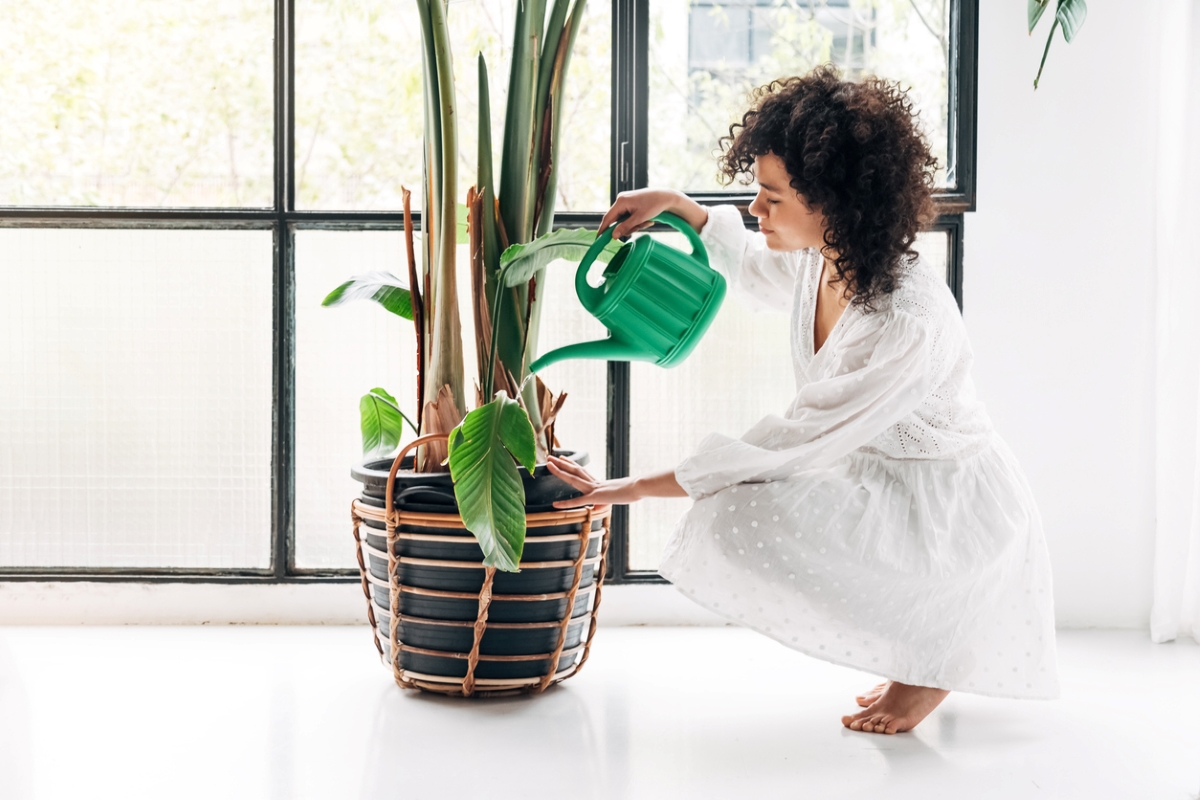We may earn revenue from the products available on this page and participate in affiliate programs. Learn More ›
Big houseplants make a bold statement, adding drama and creating a vibrant, living focal point in any room. In addition to providing a big dose of healthy benefits, a huge houseplant can bring the outside in – in a big way. Because of their size, these large plants may require special care, whether that means accommodating their spatial requirements or adjusting your watering schedule.
Whether you have nurtured smaller plants that have grown large or you short-cut the process by purchasing a large plant, it’s wise to understand the special needs of huge houseplants and be prepared to deal with the hugeness of it all.
1. Make room

Big plants require lots of space. Some tropical trees grown indoors can easily reach 8 feet to 10 feet tall, and banana trees have been known to stretch to 15 feet indoors.
Having high ceilings may not be enough. Some plants, like monstera and Philodendron selloum, which can spread up to 5 feet, are bushy plants that can grow quite wide if structural support, such as stakes, moss poles, cages, or wires, aren’t provided. Pruning can keep even the big plants manageable.
2. Light ‘em right

Just like their smaller counterparts, big houseplants may be easy or difficult to care for. Some, like the rubber tree and the ZZ plant, tolerate low light conditions, while others, particularly cacti and citrus trees, crave full sun. “There are plants like monstera and philodendrons that can grow under indirect light,” says Byron Martin, horticulturist and co-owner of Logee‘s Plants for Home and Garden.
“Not all indoor plants need large windows to accommodate them, even if they are big,” Martin continues. Finding windows big enough to provide all the light a sunlight-loving, huge houseplant needs can be challenging. Grow lights, like the LBW Stand Grow Light for Indoor Plants at Amazon, can supplement natural light.
3. Move them around

Whether your big houseplant gets to spend the summers outside after overwintering indoors or you’re just rotating it in place for even growth, it can be a struggle to move big, heavy pots.
Pots made of plastic or other lightweight material will lighten the load somewhat. Just be sure the pot is sturdy enough for the size of the plant it holds. We like this 20-Inch Bloem Dayton Planter with Saucer that is made from recycled marine plastic, making it lightweight and eco-friendly.
Wet soil is heavy soil, so try to move plants before watering them. For major moves, a furniture dolly or garden cart can assist. Routine rotation is made easier if the plant sits on a plant dolly with lockable caster wheels.
4. Tidy up the mess

Big plants can make big messes. Woody species may drop yellow leaves as they adjust to lower levels of light when brought inside. Blooming plants drop faded flowers. “Many plants have leaf drop seasonally,” Martin notes. Plumeria, a flowering, deciduous tropical tree, drops its leaves in the fall as it prepares for its winter dormancy period, as well as flowers after they’ve bloomed.
There can be a number of reasons plants drop leaves, from seasonal shifts to temperature changes to stress from over- or underwatering, pests, or disease. Sweeping up leaf litter is easier when large plants are on wheels.
5. Keep ‘em clean

Cleaning up after plants is only part of the housekeeping routine. Because houseplants are stationery, they collect dust. “As there is no rain or a way to spray the foliage down, it would have to be manually wiped with a damp cloth periodically,” Martin says.
Plants with big leaves, such as peace lilies and fiddle leaf figs, benefit from dusting with a soft, damp cloth, spritzing, or wiping off every couple of months. Not only does it make them look better, but it also enables photosynthesis and improves plant health. Thorny plants can be dusted with the Southside Plants Cactus Cleaning Brushes at Amazon or a soft-bristled paint brush.
6. Water wisely

In some ways, large plants are easier to care for than smaller ones. With a larger volume of soil, they don’t typically need watering as frequently, because smaller volumes of soil have a great surface area to volume ratio, which results in more evaporation. That, in turn, dries out the soil. “Almost universally, all plants’ potting mix should be brought to visual dryness on the surface before thoroughly saturating the growing media,” Martin explains.
Big plants also don’t need repotting as frequently. Instead of having to repot every 6-12 months, you may be able to extend it to 18-24 months for a big plant.
7. Protect pets, plants, and kids

Some of our favorite houseplants are toxic to pets and people. Since huge houseplants can’t be put in hanging baskets or high shelves, other measures must be taken to protect pets and children – and to protect the plants from the damage pets and children can do to them.
Place toxic plants in rooms off limits to pets and kids. Natural repellents, such as citrus peels, coffee grounds, cayenne pepper, or decorative stones placed on the soil may stop pets from digging. A citrus-vinegar spray on leaves can discourage chewing. Check to see if commercial repellent sprays are safe for plants.


